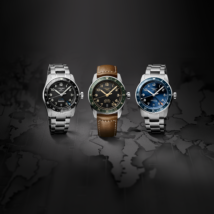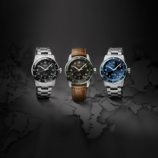Cases: The vocabulary of design
Even at the time of pocket watches, the case was essential to protect timepieces as effectively as possible against dust, damp and damage, in order to ensure accurate functioning. The watch glass and the usually enamelled watch face was often additionally protected by the spring cover of a savonette or double-shell case. In addition to stainless steel cases, silver or gold cases were produced for particularly high-value pocket watches, the faces of which mostly had complications. Such cases often had artistic hand-crafted guilloche ornamentation or engraving.
Nowadays, in addition to steel and precious-metal cases, in special alloys, titanium, carbon and high-tech ceramics are also used in the manufacture of watch cases. Each watch case, whatever form it takes, protects the workings of the timepiece against environmental damage. Additional protection is afforded by the seals in the mostly screw-in case back and the watch glass.
The classic shape
Since a timepiece, with all its functions, had to be accommodated in as small a space as possible, the round case form for pocket watches was a logical design outcome. A pocket watch case with corners and edges would moreover have been extremely impractical. The round case form was also an ideal solution for wristwatches. For this reason, at the beginning of the 20th century pocket watches were often repurposed as wristwatches by soldering lugs onto the watch casing. Rectangular or oval cases marked a new trend in the 1920s and 1930s. A number of the models designed during this period are still considered classic watches today.
Sporting origins
Rectangular watch cases set a clear stylistic tone, but in terms of shape, compared with round cases, they do have size limitations. Ensuring the balanced appearance of a watch with this shape of case also requires the display of the watch to be in harmony with the case. Watches with rectangular cases are equally suitable for both women and men, depending on design and size. Originally conceived as a gentleman’s sports model, the form has now evolved, leading to the classic design of the elegant medium-sized ladies sports watch.
Distinctive and unique
Square cases, instantly distinctive, define a whole series of classic watch models. For this reason, several of these have become true watch icons. The square case form is equally suitable for both sports and elegant watches.
Art Deco
The tonneau-shaped watch (French for ‘little barrel’) ranks among the classic forms of case, and dates back to the art deco period. The gently-rounded corners and flair of the curved edges characterize the particular appearance of this classic yet timeless case form.
Two faces
Since the 1930s, the reversible case has been a patented specialty when it comes to watch cases. Originally conceived as protection for watch glass when engaging in sporting activities, in stylistic terms, this casing design ranks among the most charming of options. It can, for instance, display a second time zone on the reverse or, if it has a solid base, it may be decorated with an engraving.
Exquisite and elegant in design
Teardrop-shaped cases are primarily used for exquisite dress watches, presenting the watch plus harmoniously designed watchband as a perfectly formed item of jewellery. This form too is a classic among watches, with timeless appeal.
Unmistakable and unique
Some watches make an unmistakable design statement. Their creative design is evident at first glance, and the extravagant conception of the watch case is the key characterizing factor in the appearance of such watches. An example of such lavish design is our watch case manufactured from titanium, combining stability with comparative lightness.
On the other side
Our special watch versions include left-handed watches. So that the crown sits on the left and the watch can also be adjusted on the wrist, the mechanism must be turned 180° within the case. In technical terms, this can be done fairly straightforwardly. The design of the dial with two or three-pointer models remains unchanged. However, in the case of additional functions, such as date, day of the week, power reserve indicator or indeed a chronograph, then a reverse arrangement of the display on the dial is required.
Octagonal cases have a particularly striking stylistic impact; they create a distinctive hallmark and moreover define the exceptional character of a watch. The case design, the key stylistic feature, establishes a convincing unity of form together with the mechanism.
Elegant and feminine
Oval cases are best suited to small or medium-sized elegant ladies’ watches. This form of case, with a sporting touch, has a timeless classic appeal and is an attractive form of watch for everyday wear.

